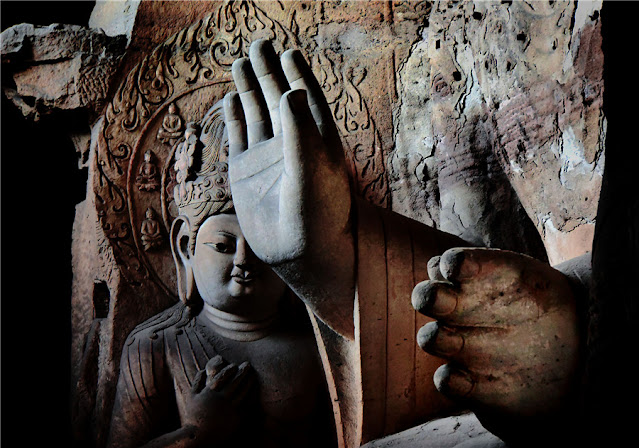The basic
teachings of the Buddha are contained in:
-
Four
Satyas (noble truths)
-
Eight
paths (Ashtangika Marga)
The four
noble truths are:
1. The world is full of sufferings.
2. All sufferings have a cause. Desire,
ignorance and attachment are the causes of these sufferings.
3. A suffering could be removed by
destroying its cause.
4. One must know the right path to end
the sufferings. This path is eight-fold or the Ashtangika Marg.
The
eight-fold path is enunciated as follows:
1. Right View/Observation: Finding the
right view through observation is the first of the paths. This is required to
understand that the world is filled with sorrow emerging from desires. Ending
the desire will lead to liberation of the self.
2. Right Aim/Determination: It refers
to having the determination for the right aim, which is to seek to avoid
enjoyment of the senses and luxury. It aims to love the humanity and augment
the happiness of others.
3. Right Speech: It emphasises the
endeavour to speak truth always.
4. Right Action: This is interpreted as
unselfish deeds or action.
5. Right Livelihood: This path
instructs a follower to live his or her life by honest means. This does not
take an extreme position. For example, it allows profit-making by business
people but without subjecting somebody to sufferings.
6. Right Exercise: This means making
the right efforts, interpreted as the proper way to control one’s senses so as
to prevent bad or detrimental thoughts. It elucidates that one can destroy
desires and attachments through right mental exercises.
7. Right Memory/Mindfulness: It
recognises that there are evil worldly affairs which trigger desires and
attachments. This path calls for understanding the idea that the body is
impermanent, and that meditation is the means for removal of the worldly evils.
8. Right Meditation/Concentration:
Observation of the right meditation will lead to inner peace. The right
meditation will unravel the real truth.
Buddhism
puts great emphasis on the law of karma (action). This means that the present
is determined by one’s past actions. Everyone is the maker of one’s own
destiny. The condition of a person in this life or the next life depends on
one’s own actions. Humans are born again and again to reap the fruits of their
karma. If an individual has no sins or desires, she or he is not born again.
The
doctrine of karma is an essential part of the Buddhist tenet. The Buddha
preached nirvana, described as the ultimate goal of a human life. One can
attain nirvana by the process of elimination of desires. The Buddha laid
emphasis the moral life of an individual to complete this process.
Buddhism is
what could be termed a secular religion for the Buddha neither accepted nor
rejected the existence of god. He did not consider the god question as
significant enough to discuss. He was more concerned about the individual and
one’s action than deliberating the question of god. The Buddha did not believe
in the existence of soul either. It is unique in being a soul-less religion.
This means there is no heaven in Buddhism.
The Buddha
emphasised on the spirit of love, which he said could be harboured for all
living beings by following the path of ahimsa, non-violence. The principle of
ahimsa was underscored and emphasised in Buddhism but not as much as in
Jainism. The Buddha prescribed that an individual should pursue the middle-path
shunning the extremes of severe asceticism and luxurious life.
The
teachings of the Buddha posed a serious challenge to the existing Brahmanical
ideas in the following ways:
1. The Buddha’s liberal and democratic
approach towards life quickly attracted people from all sections of society.
His disregard for the caste system and the supremacy of the Brahmins through
the law of karma was welcomed by the people who were given lower social strata
in the pecking order. People were admitted to the Buddhist order without the
consideration of caste and, later, gender.
2. Salvation of an individual, Buddhism
declared, depended on one’s good deeds not the birth in a particular community.
This meant that there was no need for a priest or spiritual middle-man to
achieve nirvana.
3. The Buddha also rejected the supreme
authority of the Vedas by condemning the practice of animal sacrifice. The
Buddha said neither a sacrifice to gods could wash away a sin nor could any
prayer of any priest do any good to a sinner.
With these
influences, Buddhism in a very short period emerged as an organised religion
and the Buddha’s teachings were codified forming the Buddhist cannon, the
collection of his teachings. The Buddhist cannon can be divided into three
sections:
1. Sutta Pitaka: It consists of five
Nikayas (bodies) of religious discourses and sayings of the Buddha. The fifth
of the Nikayas contains the Jatakakathas (the tales of the births).
2. Vinaya Pitaka: It contains the rules
for monastic discipline.
3. Abhidhamma Pitaka: It contains the
philosophical ideas of the teachings of the Buddha. It is written in the form
of questions and answers.


No comments:
Post a Comment